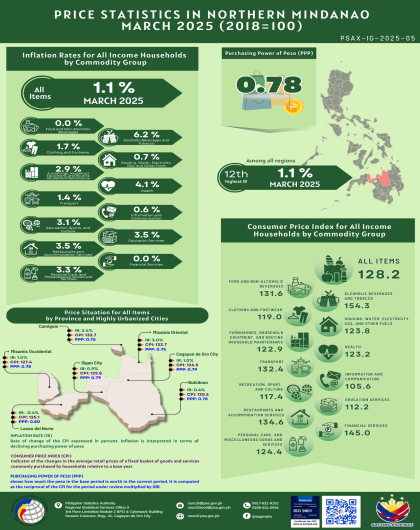The region’s year-on-year headline inflation rate recorded at 4.3 percent in April 2019, higher than the 4.10 percent in March 2019 and 4.0 percent during the same period a year ago. (See Figure 1)


Among the provinces, Bukidnon recorded the highest inflation at 5.2 percent in April 2019 while Misamis Oriental recorded the lowest inflation at 3.7 percent. (See Table 1)

Among the commodity groups, alcoholic beverages & tobacco and housing, water, electricity, gas and other fuels recorded the top 2 biggest inflation rates in April 2019 at 11.0 percent and 8.4 percent, respectively. (See Figure 2)
The uptrend of inflation was primarily due to the increase of inflation rate of the housing, water, electricity, gas and other fuels from 7.9 percent in March 2019 to 8.4 percent in April 2019; transport from 0.8 percent to 3.3 percent, and communication from 0.0 percent to 0.1 percent. (See Table 2)
The other commodity groups either had slower annual add-ons or retained previous month’s inflation rate.
On the other hand, the inflation rate for food had decelerated from 3.0 percent in March 2019 to 2.9 percent in April 2019. Most of the items in the food group recorded a slower inflation rates in April 2019 as compared in March 2019. Furthermore, most of the food items posted a decrease in price in April 2019, namely, fish, fruit, meat, bread & cereals, oils & fats and sugar, ham, honey and confectionery. Meanwhile, inflation rate of vegetables inched up to 4.8 percent in April 2019 as compared in March 2019. (See Table 3)


Among the provinces, Misamis Occidental posted the biggest inflation rate in the food and non-alcoholic beverages at 6.2 percent while Lanao del Norte posted the lowest inflation rate at 0.8 percent in April 2019. (See Table 4)

For housing, water, electricity, gas and other fuels, Lanao del Norte posted the biggest inflation rate at 12.5 percent while Misamis Occidental posted the lowest inflation rate of add-on at 3.1 percent. (See Table 4)
PURCHASING POWER OF PESO
The region’s average purchasing power of peso in April 2019 remained steady at PhP 0.80. This is however weaker as compared to the purchasing power of peso in April 2018 at PhP 0.84. (See Figure 3)
The average purchasing power of peso in all provinces also declines in April 2019 over the same period in the previous year. The provinces of Bukidnon and Camiguin posted the biggest decrease of purchasing power in April 2019 from the same period of 2018.

(Sgd.) JANITH C. AVES, CE, DM
(Chief Statistical Specialist)
Officer-in-Charge
TECHNICAL NOTES
Consumer Price Index (CPI)-The CPI is an indicator of the changes in the average retail prices of a fixed basket of goods and services commonly purchased by households relative to a base year.
Uses of CPI- The CPI is most widely used in the calculation of the inflation rate and purchasing power of peso. It is a major statistical series used for economic analysis and as a monitoring indicator of government economic policy.
Computation of CPI- The computation of the CPI involves consideration of the following important points:
a. Base Period -The reference date or base period is the benchmark or reference date or period at which the index is taken as equal to 100.
b. Market Basket- A sample of the thousands of varieties of goods purchased for consumption and services availed by the households in the country selected to represent the composite price behavior of all goods and services purchased by consumers.
c. Weighting System -The weighting pattern uses the expenditures on various consumer items purchased by households as a proportion to total expenditure.
d. Formula -The formula used in computing the CPI is the weighted arithmetic mean of price relatives, the Laspeyre’s formula with a fixed base year period (2012) weights.
e. Geographic Coverage- CPI values are computed at the national, regional, and provincial levels, and for selected cities.
Inflation Rate- is the rate of change of the CPI expressed in percent. Inflation is interpreted in terms of declining purchasing power of peso.
Purchasing Power of Peso (PPP)- shows how much the peso in the base period is worth in the current period. It is computed as the reciprocal of the CPI for the period under review multiplied by 100.
For further inquiries, you may contact:
Statistical Operations & Coordination Division
Philippine Statistics Authority Regional Statistical Service Office 10
2nd Floor, Bldg. 4, Pride Rock Business Park
Gusa Highway, Cagayan de Oro City
Email: psaregion10@gmail.com
Telefax:(088) 856-4778


